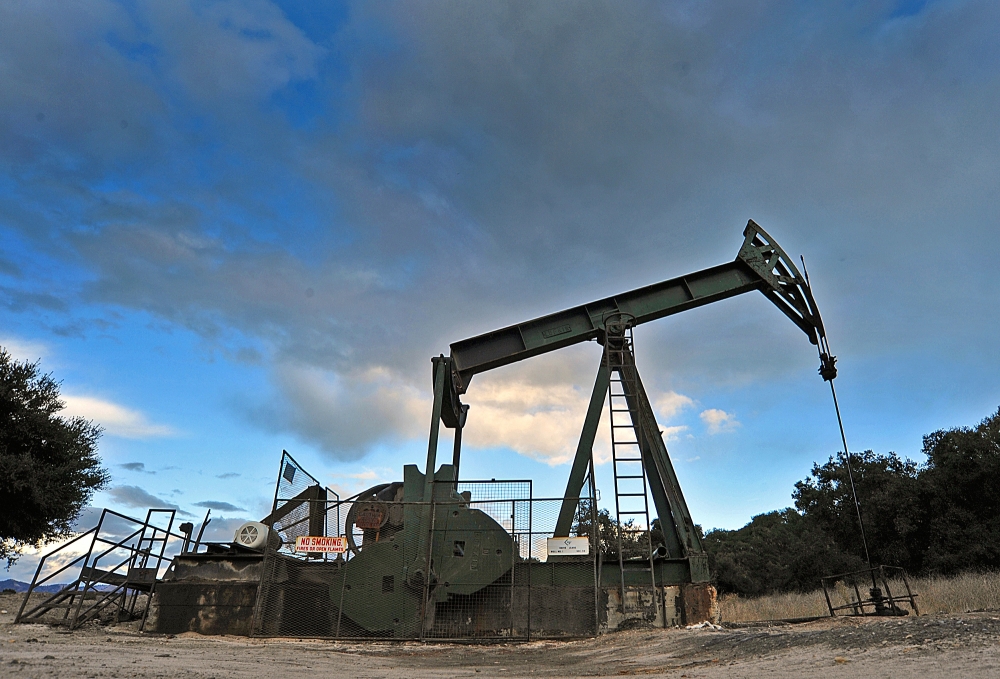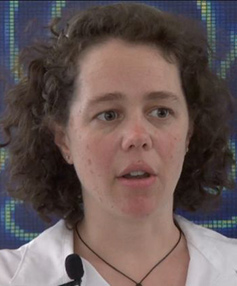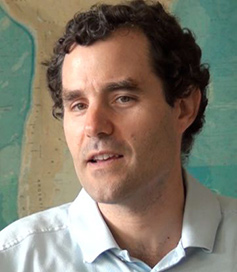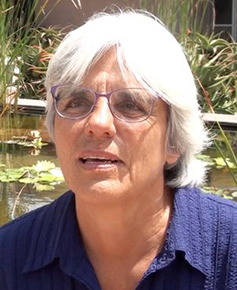
To Frack or Not to Frack?
Hydraulic fracturing is a polarizing issue, one that will be addressed at the polls in several California counties — including Santa Barbara — in November. Better known as fracking, the process releases gas or oil trapped in shale by injecting water, sand and chemical additives under high pressure.
Chemicals used in the extraction process pose potential risks to water quality, and the industry’s demand for water can create conflicts with residential and agricultural water users as well as ecological communities. However, the overarching problem is a lack of integrated knowledge.
“Right now, a lot of the decisions and debate about hydraulic fracturing, unconventional oil and gas development, are taking place in the press and the court of public opinion with very little data and information informing that,” said Joe Kiesecker, lead scientist for The Nature Conservancy’s Global Conservation Lands Program. He is part of a two-year working group organized under the auspices of Science for Nature and People (SNAP) that aims to change that.
SNAP is a scientific collaboration among UC Santa Barbara’s National Center for Ecological Analysis and Synthesis (NCEAS), The Nature Conservancy and the Wildlife Conservation Society.
“There are thousands of news articles that have been written about hydraulic fracturing or fracking but only a handful of scientific papers that seek to inform how and where and what the risk is around it,” continued Kiesecker, who is a co-lead of the SNAP working group.
Consisting of specialists from academic institutions and conservation organizations across the United States, the group, Grounding Hydraulic Fracturing Policy in Science, meets twice yearly at UCSB’s NCEAS. There, group members discuss how they can provide better science on the potential effects of water withdrawals and chemical contamination associated with hydraulic fracturing.
 “Hydraulic fracturing can be very contentious and part of it is the lack of information and data.”
“Hydraulic fracturing can be very contentious and part of it is the lack of information and data.”
Sharon Baruch-Mordo
The Nature Conservancy
“Hydraulic fracturing can be very contentious and part of it is the lack of information and data,” said Sharon Baruch-Mordo, a spatial scientist with The Nature Conservancy and one of the leads of the SNAP working group. “So that’s exactly where we want to come in as objective researchers and collect information and ask the questions a lot of citizens and regulators are asking.”
Rather than conduct primary research, this interdisciplinary group of ecologists, hydrologists and legal experts is synthesizing fine-scale information from the 48 contiguous states and reviewing existing water use and waste management plans. The group's final report will be used to inform best management practice recommendations for states and countries with emerging fracturing industries.
The History of Fracking
Fracking began as an experiment in 1947, and the first commercially successful application followed two years later. According to the Department of Energy, as of 2013, at least 2 million oil and gas wells in the U.S. have been hydraulically fractured, and up to 95 percent of new wells being drilled are hydraulically fractured. According to Jim Boles, UCSB professor emeritus in geology, only 5 percent of wells in California — none in Santa Barbara County — are fracked to recover oil rather than gas.
Boles notes that while hydraulic fracturing procedures have to meet certain state and federal requirements, the bigger problem is using old casing or poor cement jobs. “When fracking is done improperly, problems arise, particularly if wells aren’t properly completed,” said David Valentine, a professor in UCSB’s Department of Earth Science and an expert in microbial geochemistry.
 “There are big operators and there are small operators, so it’s very hard to maintain the same level of quality in how things are done.”
“There are big operators and there are small operators, so it’s very hard to maintain the same level of quality in how things are done.”
David Valentine
professor of earth science
“In that case, there is a high potential for chemicals to get into the drinking water supply or into the groundwater,” Valentine said. “But if things are done properly, chemicals are released so far down in the subsurface that they’re not going to be coming up any time in the foreseeable future. One of the big issues is that every operator does things differently. There are big operators and there are small operators, so it’s very hard to maintain the same level of quality in how things are done.”
In Santa Barbara County, a process called cyclic steam injection is being used to access oil in pockets that cannot be reached directly. The process uses non-potable water that is heated to thin the viscous oil so that it can be sucked up to the surface.
With fracking, in addition to the potential for contamination from chemical additives, water use is another issue, particularly in drought-stricken states. For example, in 2010, water use in Texas’s Barnett Shale represented 9 percent of water use in Dallas, one of the 10 most populous cities in the U.S.
Because many of the risks of hydraulic fracturing are still not fully known or quantified, the SNAP working group fills a gap in existing research and policy work. The investigators’ goal is to identify the risks, determine which risks should be priorities and then specify policies that better address those risks.
 “We will produce a document that investigates various risk or impact pathways … that could lead to problematic consequences for humans, wildlife and habitat.”
“We will produce a document that investigates various risk or impact pathways … that could lead to problematic consequences for humans, wildlife and habitat.”
Hannah Wiseman
law professor
“We will produce a document that investigates various risk or impact pathways and the types of activities at shale gas and oil sites that could lead to problematic consequences for humans, wildlife and habitat,” said Hannah Wiseman, an assistant professor at the Florida State University College of Law who is part of SNAP’s hydraulic fracturing working group. “We will then, after identifying those potential impact pathways, look at policy options for mitigating those impacts or preventing them from the start and provide some sort of menu of policy options for states as well as other countries to use as potential models.”
Secondary Effects
Another concern, according to some scientists, is the potential for fracking to create small — largely unnoticeable — earthquakes. Climate change expert Catherine Gautier, professor emerita in the Department of Geography, notes that because fracking pushes water into the ground under high pressure, it creates cracks that can affect seismic activity. “It’s not the process itself that generates earthquakes, it’s putting the water back into the ground,” she explained. “What happens to the water depends on where it is and what cracks exist where it can come back up. The research is not there to know how fast it will come back and where it will migrate.”
 “No matter how oil or gas is extracted, there is methane that leaks.”
“No matter how oil or gas is extracted, there is methane that leaks.”
Catherine Gautier
professor emerita of geography
As a climatologist, Gautier is also worried about the secondary effects of releasing methane into the atmosphere, an event largely overlooked in the ongoing fracking debate. “No matter how oil or gas is extracted, there is methane that leaks,” she explained. “Methane is really, really bad for the climate because it has high potential for contributing to the greenhouse effect.”
When it comes to greenhouse gas emissions, the warming effect of methane is 30 to 100 times more potent than carbon dioxide, scientists say. “There is research being done on what happens to the methane, but it depends on whether it can be tracked and the time scale examined,” Gautier added. “If you look at methane over a 20-year period, it’s much more powerful than if you look at it over 100 years. On the other hand, carbon dioxide — the primary driver of global climate change — is problematic at the 100-year time scale.”
Reduction of carbon emissions is important to both the state of California and Santa Barbara County. “Our county has a plan to decrease carbon emissions consistent with the state of California,” said Corrie Ellis, a sociology graduate student and community activist. “These techniques, including cyclic steam injection, are really carbon intensive. Their emissions are not really compatible with the county’s plan.”
 “Traditional forms of energy are still going to be in the mix.”
“Traditional forms of energy are still going to be in the mix.”
Joe Kiesecker
The Nature Conservancy
While the SNAP working group is careful not to take sides on the issue of fracking, Kiesecker noted that potential benefits in using unconventional oil and gas development exist. “Clearly the potential is there for reductions in CO2 emissions relative to coal if we can figure out issues such as methane emission,” he said. “The reality is that in the next 20 to 30 years energy demand is going to increase dramatically. And we’re going to have to find a variety of ways to meet those growing energy needs.
“Traditional forms of energy are still going to be in the mix,” Kiesecker continued. “The debate is really about how we develop those energy resources and where. Any kind of energy development has an impact, so the question is: How can we do a better job as we develop unconventional oil and gas through hydraulic fracturing as well as wind energy or solar energy? All can be done better.”



